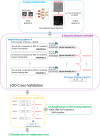Early prediction of neoadjuvant chemotherapy response by exploiting a transfer learning approach on breast DCE-MRIs
- PMID: 34238968
- PMCID: PMC8266861
- DOI: 10.1038/s41598-021-93592-z
Early prediction of neoadjuvant chemotherapy response by exploiting a transfer learning approach on breast DCE-MRIs
Abstract
The dynamic contrast-enhanced MR imaging plays a crucial role in evaluating the effectiveness of neoadjuvant chemotherapy (NAC) even since its early stage through the prediction of the final pathological complete response (pCR). In this study, we proposed a transfer learning approach to predict if a patient achieved pCR (pCR) or did not (non-pCR) by exploiting, separately or in combination, pre-treatment and early-treatment exams from I-SPY1 TRIAL public database. First, low-level features, i.e., related to local structure of the image, were automatically extracted by a pre-trained convolutional neural network (CNN) overcoming manual feature extraction. Next, an optimal set of most stable features was detected and then used to design an SVM classifier. A first subset of patients, called fine-tuning dataset (30 pCR; 78 non-pCR), was used to perform the optimal choice of features. A second subset not involved in the feature selection process was employed as an independent test (7 pCR; 19 non-pCR) to validate the model. By combining the optimal features extracted from both pre-treatment and early-treatment exams with some clinical features, i.e., ER, PgR, HER2 and molecular subtype, an accuracy of 91.4% and 92.3%, and an AUC value of 0.93 and 0.90, were returned on the fine-tuning dataset and the independent test, respectively. Overall, the low-level CNN features have an important role in the early evaluation of the NAC efficacy by predicting pCR. The proposed model represents a first effort towards the development of a clinical support tool for an early prediction of pCR to NAC.
Conflict of interest statement
The authors declare no competing interests.
Figures




References
Publication types
MeSH terms
Substances
LinkOut - more resources
Full Text Sources
Medical
Research Materials
Miscellaneous

